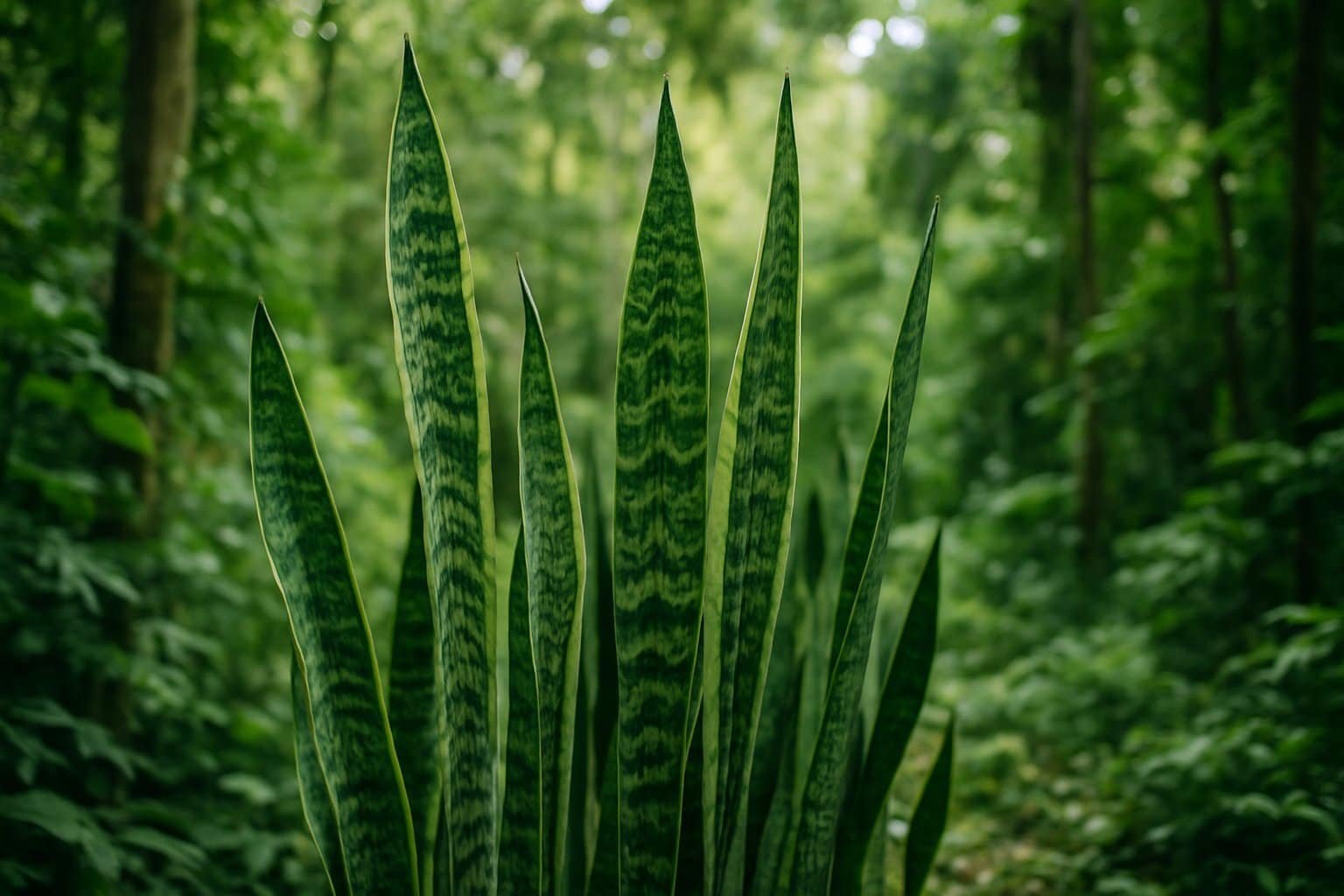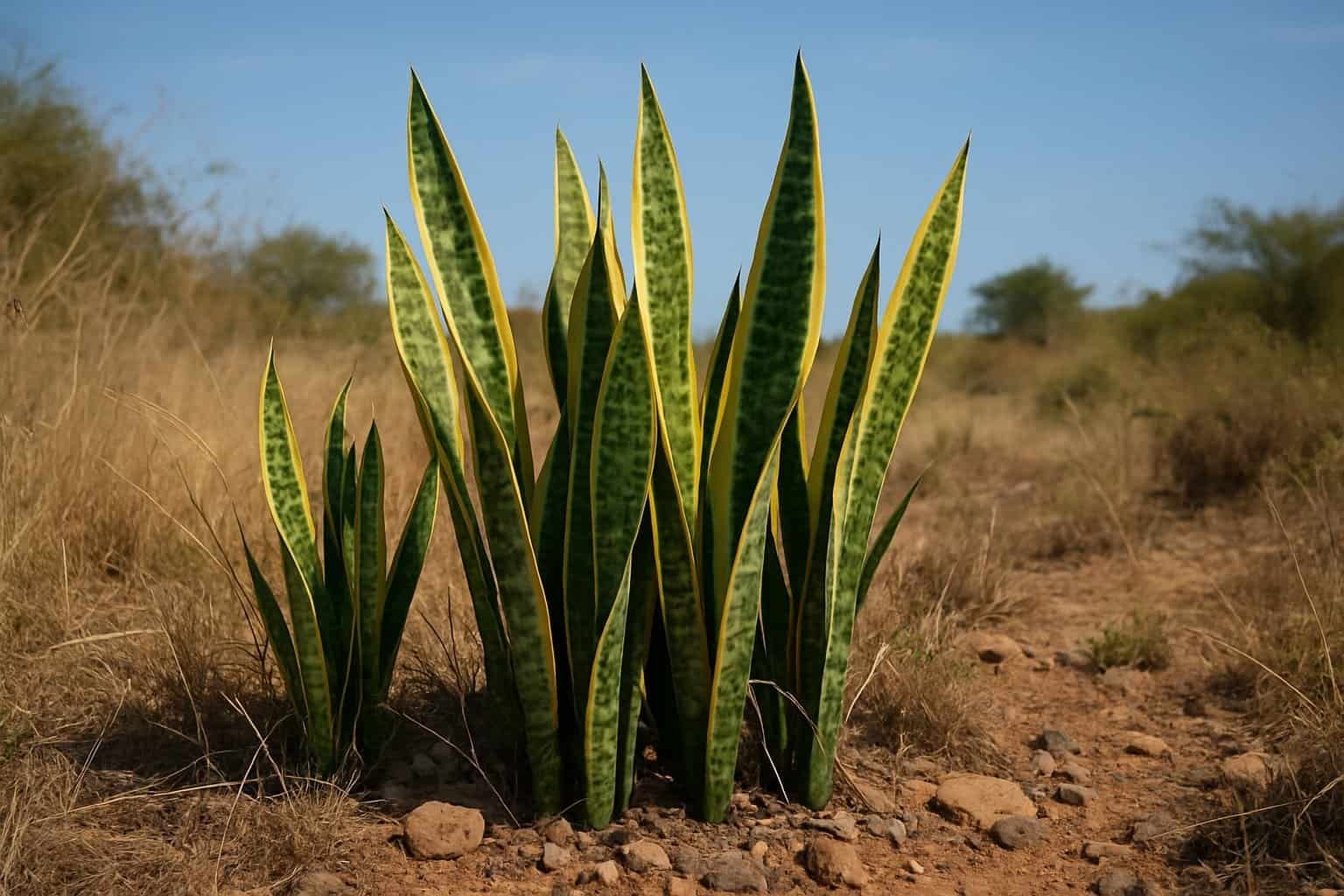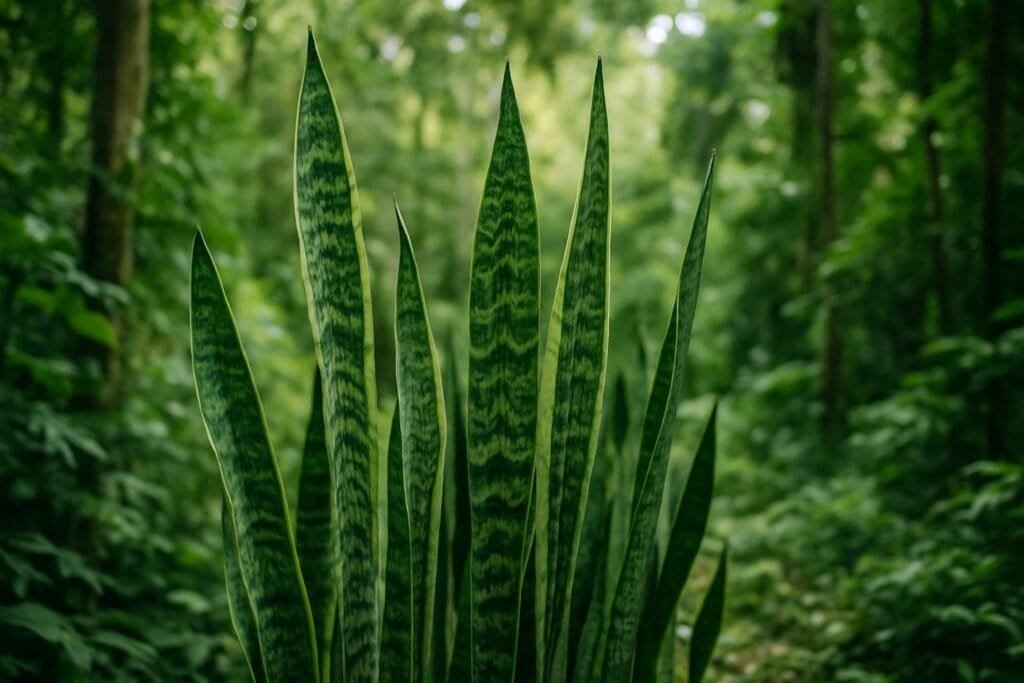Snake plants, also called Sansevieria or Dracaena, are popular houseplants admired for their striking appearance and easy care. Many plant owners don’t realize these sturdy plants have specific native origins.

Snake plants are native to West Africa, especially countries like Nigeria, Congo, and Angola. Some species also grow in southern and eastern Africa, Madagascar, and parts of southern Asia.
Their natural habitat consists of dry, rocky terrain. They have evolved to survive with minimal water and varying light conditions.
These resilient plants grow in arid regions where they must withstand long periods of drought and intense sun. This makes them adaptable to indoor environments and able to thrive even when neglected.
Key Takeaways
- Snake plants originate from Africa and parts of southern Asia where they grow in dry, rocky environments.
- Their natural drought tolerance and adaptability to varying light conditions make them excellent houseplants.
- Some wild snake plant species face habitat loss in their native regions.
Origins and Native Habitat of Snake Plants
Snake plants, known scientifically as Dracaena trifasciata, have adapted to thrive in specific environments over thousands of years. Their natural distribution covers regions of Africa, where they evolved unique characteristics to survive in tough conditions.
Geographic Regions Where Snake Plants Are Indigenous
Snake plants are native to tropical and subtropical regions of West and Central Africa. They mainly grow in countries like Nigeria, Congo, and other parts of tropical Africa.
In these areas, snake plants often grow in rocky outcrops, woodland margins, and thickets. Their strongest presence is in West Africa, where different varieties have evolved with slight differences in leaf patterns and growth habits.
Some varieties develop taller, more upright leaves. Others spread in a more rosette-like formation.
These hardy plants grow in both shaded forest understories and exposed locations, showing their adaptability even in their native environment.
Native Climate and Ecosystem Factors
Snake plants thrive in arid to semi-arid environments with irregular rainfall. In their native habitat, they experience wet and dry seasons with long droughts.
This climate has shaped their water storage abilities. The soil in their native regions is usually well-draining, sometimes rocky or sandy.
These conditions prevent root rot, which often affects snake plants in overly moist environments. Temperatures in their native range stay warm year-round, rarely dropping below 50°F (10°C).
The plants withstand intense sunlight, though they often grow partially shaded by larger plants.
Historical Distribution and Natural Range
Historically, snake plants grew scattered across savanna ecosystems and dry forest edges in Africa. They established themselves in ecological niches where they could compete with other vegetation.
Before humans spread them, snake plants grew slowly through rhizome growth and occasional seed production. Their tough, fibrous root systems helped them survive where other plants struggled.
Indigenous peoples valued the plant for centuries, using its fibers for bowstrings, rope, and traditional medicine. This relationship between humans and snake plants goes back many generations.
Tribes sometimes carried useful plants between settlements, expanding the plant’s range. Still, its main distribution stayed within tropical Africa until global trade spread it worldwide.
Key Species and Taxonomy of Snake Plants

Snake plants include several important species that have been reclassified in recent years. Their botanical identity changed from Sansevieria to Dracaena, causing some confusion in scientific literature and garden centers.
Dracaena Trifasciata and Its Synonyms
Dracaena trifasciata is the scientific name for the most common snake plant, formerly called Sansevieria trifasciata. Genetic studies revealed snake plants belong to the Dracaena genus.
The plant keeps several common names, including “mother-in-law’s tongue,” “saint george’s sword,” and “viper’s bowstring hemp.” The “Laurentii” cultivar, with yellow leaf edges, remains especially popular.
This evergreen perennial grows slowly but can reach 3-4 feet tall in good conditions. Indigenous people in their native regions used the strong leaf fibers to make bowstrings, giving rise to the name “bowstring hemp.”
Other Prominent Snake Plant Species
Several other notable snake plant species exist beyond Dracaena trifasciata:
- Dracaena angolensis (formerly Sansevieria cylindrica): Known as “cylindrical snake plant” with round, spear-like leaves.
- Dracaena francisii: Features unusual patterning with dark green patches.
- Dracaena masoniana: Called “Whale Fin” due to its wide, single leaves.
- Dracaena ballyi: Known as “dwarf sansevieria” with compact growth.
The “Bird’s Nest” snake plant (Dracaena trifasciata ‘Hahnii’) forms a short rosette resembling a bird’s nest. This compact variety rarely exceeds 6 inches in height and suits small spaces.
Classification Within Asparagaceae
Snake plants belong to the Asparagaceae family, which includes asparagus, agaves, and yuccas. This family contains about 114 genera and 2,900 species.
Key classification hierarchy:
- Kingdom: Plantae
- Order: Asparagales
- Family: Asparagaceae
- Subfamily: Nolinoideae
- Genus: Dracaena
Molecular studies revealed their close relationship to Dracaena, leading to the reclassification in 2017. Many gardeners and some commercial sources still use the Sansevieria name.
This taxonomic change shows how plant classification evolves as scientific understanding grows through DNA analysis.
Natural Environments and Environmental Adaptations

Snake plants thrive in diverse conditions thanks to their remarkable adaptations. These hardy plants have evolved traits that allow them to flourish in their native habitats and survive in various settings.
Soil Types and Ground Conditions
Snake plants naturally grow in sandy, rocky, and well-draining soils. In their native African habitats, they often establish in poor soil conditions where many other plants struggle.
Their robust root system penetrates tough ground, anchoring the plant and absorbing limited nutrients. This adaptation explains why snake plants can thrive in less-than-ideal potting mixtures.
In the wild, snake plants often grow in areas with rocky outcrops or sandy patches. They prefer soil that doesn’t retain too much moisture, since their thick, fleshy leaves store water.
Gardeners can mimic these conditions by using cactus mix or adding sand and perlite to regular potting soil.
Adaptation to Arid and Tropical Climates
Snake plants show great versatility across different climate zones. In arid regions, they conserve water through specialized leaf structures and modified photosynthesis.
Their thick, waxy leaves minimize water loss. This adaptation lets them survive long periods of drought, sometimes months without rainfall.
Snake plants also thrive in tropical forests as understory plants. In these environments, they tolerate inconsistent light and higher humidity.
Their ability to photosynthesize efficiently in low light helps them succeed in forests. This also explains why they do well as indoor plants with limited natural light.
Snake plants can handle both hot days and cool nights typical of African savannas and semi-desert regions.
Interaction With Local Ecosystems
Snake plants play important roles in their native ecosystems. Their deep roots help prevent soil erosion in areas with sparse vegetation.
During dry periods, these plants stay green when other vegetation withers. This provides habitat and shelter for small animals and insects when resources are scarce.
Some species produce fragrant flowers that attract moths. These night-blooming flowers are part of the nocturnal ecosystem.
Snake plants developed mild toxicity as a defense against herbivores. Their leaves contain compounds that discourage grazing animals, though some specialized insects can feed on them.
Wild snake plants participate in complex ecological relationships that maintain biodiversity in their native habitats.
Growth Habits and Propagation in the Wild
Snake plants have unique growth habits that help them thrive in their native African environments. Their physical features and reproduction methods have enabled them to survive in harsh conditions for millions of years.
Leaf Shape and Structural Adaptations
Snake plants have stiff, sword-like leaves that grow vertically from a basal rosette. These leaves are succulent, storing water in thick tissues to survive drought.
Leaves typically grow 1-4 feet tall, depending on the species. Some varieties display yellow borders.
A waxy cuticle covers the leaf surface, reducing water loss. This adaptation is crucial in arid regions.
Snake plants are evergreen perennials, keeping their foliage year-round. They use crassulacean acid metabolism (CAM) photosynthesis, opening their stomata at night to collect carbon dioxide and reduce water loss during hot days.
Root System and Rhizome Development
Snake plants develop robust underground rhizomes—thick, horizontal stems just beneath the soil surface. These rhizomes store nutrients and water, helping the plant survive drought.
The rhizome system spreads horizontally, letting the plant colonize new areas. New shoots emerge from these rhizomes, creating dense clusters in the wild.
Below the rhizomes, fibrous roots anchor the plant and absorb moisture and nutrients. These roots extract water from dry soil and grow deeper during drought.
In their native habitats, these root adaptations help snake plants thrive in rocky, sandy soils. The rhizome network also stabilizes soil in their environment.
Natural Propagation Methods
In the wild, snake plants mainly propagate through spreading rhizomes. As rhizomes extend, new shoots emerge, creating a colony of genetically identical plants.
Snake plants also reproduce by flowering. They produce greenish-white, fragrant flowers on tall stalks, usually blooming at night.
Moths pollinate the flowers, which then develop into orange-red berries with seeds. Birds and animals eat the berries and disperse the seeds.
However, seed germination rates are low compared to rhizome propagation. Environmental stress like drought or damage can trigger propagation.
When leaves break off and fall onto suitable soil, they can sometimes root and grow into new plants.
From Native Habitats to Indoor Houseplants
Snake plants have moved from wild African origins to become beloved houseplants worldwide. Their adaptability has allowed them to thrive indoors while keeping the resilience developed in their native habitats.
Transition to Cultivation as a Houseplant
Snake plants became popular houseplants during the Victorian era, when exotic plants were fashionable in European homes. Botanists and explorers brought specimens back from Africa in the 19th century.
These plants quickly earned a reputation as low-maintenance houseplants because they can survive irregular watering and various light conditions. This makes them perfect for beginners.
Snake plants kept their drought-resistant nature indoors, helping them succeed as houseplants. Many varieties, including the popular “Moonshine” with silvery-gray leaves, were developed through selective breeding to enhance their appeal for indoor use.
Role in Indoor Air Quality and Air-Purifying Qualities
Snake plants are exceptional air purifiers. NASA’s Clean Air Study recognized their ability to remove toxins like formaldehyde, benzene, toluene, and trichloroethylene from indoor environments.
These plants uniquely convert carbon dioxide into oxygen at night. Most plants only do this during the day, but snake plants continue the process around the clock.
The thick leaves of snake plants filter the air by trapping airborne particles. Even one medium-sized plant can noticeably improve a room’s atmosphere.
For people with allergies or respiratory issues, snake plants help by increasing humidity and reducing airborne allergens.
Popularity and Uses in Decor
Snake plants are popular in home design for their upright growth and bold form. Their structure adds a modern touch to any space, whether on a tabletop or as a floor plant.
The “Sansevieria trifasciata” variety has dramatic yellow leaf edges. This look fits both minimalist and maximalist decor styles.
Interior designers recommend snake plants because they thrive in low-light conditions and add visual interest. In feng shui, people believe snake plants bring good luck and positive energy.
Many place them in bedrooms, living rooms, and offices to promote harmony. Their easy care and health benefits make them a favorite for busy homeowners.
Light, Water, and Environmental Needs
Snake plants thrive in many conditions due to their adaptable nature. Their survival skills make them excellent houseplants that handle different light levels, infrequent watering, and varying temperatures.
Sunlight and Light Conditions
Snake plants handle many light situations well. They prefer bright, indirect light but also tolerate low light.
In their native African habitats, snake plants often grow in dappled sunlight under trees. In low light, they grow more slowly and may lose some leaf patterns.
Too little light can cause leggy growth. Direct sunlight is fine if you introduce it gradually to avoid leaf burn.
Morning sun is gentler than afternoon sun. Outdoors, partial shade works best in hot climates.
Indoors, east or west-facing windows provide good light. North-facing windows are also suitable, though growth will be slower.
Watering Requirements and Drought Resistance
Snake plants tolerate drought well. Their succulent leaves store water, helping them survive dry periods.
Watering guidelines:
- Water only when soil is completely dry (every 2-4 weeks)
- In winter, water once every 4-6 weeks
- Use the finger test: insert a finger 2 inches into the soil to check for moisture
Overwatering is the biggest risk and causes root rot. Yellow, mushy leaves mean too much water.
During spring and summer, water a bit more often to support new growth. Always use pots with drainage holes.
In very dry indoor air, occasional misting can help, but snake plants do not need it to survive.
Temperature and Humidity Tolerance
Snake plants do well in home temperatures between 65-85°F (18-29°C). They can survive short drops to 50°F (10°C), but cold damages them.
They cannot survive frost or freezing. Hot temperatures rarely cause problems if the plant has good ventilation.
In extreme heat, water them slightly more often. Snake plants do not need high humidity and grow well in:
- Dry climates
- Average home humidity (30-50%)
- Bathrooms with higher humidity
Their ability to handle different humidity levels comes from evolving in places with big temperature changes.
Optimal Growing Conditions in Cultivation
Use well-draining soil for healthy snake plants. Commercial cactus or succulent mixes work well.
You can also mix regular potting soil with perlite or sand to improve drainage. Snake plants like being slightly pot-bound.
When repotting, choose containers only 1-2 inches larger than the root ball. Repot every 2-3 years.
Fertilize sparingly:
- Apply diluted houseplant fertilizer once in spring and once in summer
- Do not fertilize in fall and winter
Too much fertilizer harms snake plants. Leave them undisturbed for best growth.
Rotate the pot every few months for even growth. Wipe the leaves with a damp cloth to keep them clean and healthy.
Conservation Status and Sustainable Practices
Snake plants face challenges in their native habitats from habitat destruction and over-collection. Conservation efforts aim to protect these resilient plants in the wild.
Wild Population Trends and Habitat Loss
Snake plants (Dracaena trifasciata, formerly Sansevieria) grow naturally in West Africa, especially Nigeria, and parts of Asia. Their wild populations have declined in recent decades.
Main threats include:
- Deforestation for agriculture and cities
- Over-harvesting for the plant trade
- Habitat fragmentation leading to isolated groups
- Climate change affecting arid ecosystems
In Nigeria, rapid urbanization has destroyed much of their natural habitat. Slow growth makes it hard for populations to recover after disturbance.
Conservation Efforts
Some countries have created protected areas where snake plants grow naturally. These reserves limit collection and development.
Botanical gardens keep genetic diversity safe with seed banks. The Royal Botanic Gardens Kew stores snake plant seeds in their Millennium Seed Bank.
Researchers catalog wild populations to monitor changes and identify at-risk varieties. Local communities in West Africa help with conservation by using sustainable harvesting and protecting habitats.
Sustainable Growing and Propagation
Home growers can help conservation with sustainable practices:
- Buy responsibly – Choose nurseries that grow their own plants instead of selling wild-collected ones.
- Propagate at home – Multiply snake plants with leaf cuttings or division to reduce wild demand.
- Share with others – Trade cuttings with other plant lovers to lower commercial pressure on wild populations.
Many botanical gardens offer propagated snake plants with documented origins. This gives an ethical alternative to wild-harvested plants.
Growing snake plants at home also helps preserve genetic diversity outside their native range.
Frequently Asked Questions
People often want to know where snake plants come from and how they spread around the world. These questions explain the origins and habits of these popular houseplants.
What regions of the world do snake plants originally come from?
Snake plants are native to West Africa, mainly from Nigeria to Congo. Some species also grow in southern and eastern Africa, including Madagascar.
Sansevieria trifasciata (now Dracaena trifasciata) comes from tropical West Africa.
How did snake plants adapt to different climates outside their native habitat?
Snake plants have thick, succulent leaves that store water. This helps them survive long dry periods.
Their waxy leaf coating reduces water loss. This allows them to grow in many climates.
Snake plants use CAM photosynthesis, which lets them absorb carbon dioxide at night and save water.
Can you explain the origin and distribution of snake plants in the wild?
Snake plants evolved in dry, tropical regions of Africa with seasonal rainfall. They belong to the Asparagaceae family.
In the wild, they usually grow in sandy or rocky soils with good drainage. Different species adapted to local conditions across Africa.
Their distribution grew through natural seed dispersal and later through human cultivation.
What is the historical range of snake plants before cultivation?
Before humans cultivated them, snake plants grew only in Africa. Their range mainly covered West African tropical and subtropical regions.
Some species had smaller ranges in specific habitats. Some dwarf varieties evolved in very localized areas.
Archaeological evidence shows humans used these plants for thousands of years for fiber and medicine.
In which countries are snake plants indigenous?
Snake plants naturally grow in Nigeria, Congo, Ghana, and other West African countries. Other species are native to Tanzania, Kenya, and parts of East Africa.
Some varieties are native to Angola and Namibia in southern Africa. Madagascar has several unique snake plant species.
Ethiopia and Sudan also have indigenous snake plant populations, especially in dry regions.
What ecosystems do snake plants naturally occur in?
Snake plants thrive in dry woodland areas and savannas across Africa. They often grow in partially shaded areas beneath larger trees and shrubs.
Rocky outcrops and well-drained soils create ideal conditions for wild snake plants. You can often find them in transitional zones between forests and open grasslands.
In their natural settings, snake plants grow in clusters through underground rhizome systems. This growth pattern helps them spread and form colonies in favorable locations.


